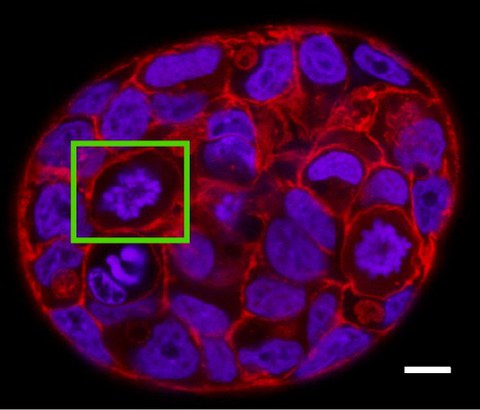Sep 02, 2020
How do tumor cells divide in the crowd?

A mini-tumor of human breast epithelial cells (MCF-7). A dividing cell indicated in green.
Scientists led by Dr. Elisabeth Fischer-Friedrich, group leader at the Excellence Cluster Physics of Life (PoL) and the Biotechnology Center TU Dresden (BIOTEC) studied how cancer cells are able to divide in a crowded tumor tissue and connected it to the hallmark of cancer progression and metastasis, the epithelial-mesenchymal transition (EMT).
Most animal cells need to become spherical in order to divide. To achieve this round shape, the cells must round up and deform their neighboring cells. In a growing tumor tissue, the tumor cells need to divide in an environment that is becoming more crowded than the healthy tissue. This means that the dividing tumor cells likely need to generate much higher mechanical forces to round up in such a densely packed surrounding. Yet, tumor cells seem to be adapted to overcome these difficulties. Scientists led by Dr. Elisabeth Fischer-Friedrich were curious how do the tumor cells gain this enhanced ability to deal with the crowded tumor environment?
The researchers found that the EMT could be one of the answers. What is it exactly? “EMT or epithelial-mesenchymal transition is a hallmark of cancer progression,” says Kamran Hosseini, PhD student who performed the experiments. It is a cell transformation during which tumor cells lose their asymmetric organization and detach from their neighbors, gaining the ability to migrate into other tissues. This, together with other factors, allows tumors to metastasize, i.e., move into the blood and lymphatic vessels and ultimately colonize other organs.
“So far, EMT has been mainly linked to this enhanced cell dissociation and cell migration. Our results suggest that EMT might also influence cancer cells by promoting successful rounding and cell division. These results point towards a completely new direction of how EMT could promote metastasis of carcinoma in the body,” explains Kamran Hosseini.
Just as we test the ripeness of the fruits by squeezing them gently with our hands, the scientists examined the mechanical properties of individual human cells. Except, they squished the cells using an atomic force microscope. This state-of-the-art setup measured properties such as cell stiffness and cell surface tension before and after the EMT. In addition, the group of Dr. Elisabeth Fischer-Friedrich in collaboration with Dr. Anna Taubenberger (BIOTEC, TU Dresden) and Prof. Carsten Werner (IPF, Dresden) cultured mini-tumors and trapped them inside elastic hydrogels to check how mechanical confinement affects cell rounding and division of tumor cells.
The authors identified changes in rounding and growth of the tumor. EMT influenced the cancer cells in two contrasting ways. The dividing tumor cells became stiffer while surrounding non-dividing cells became softer. Furthermore, the researchers found hints that the observed mechanical changes could be linked to the increased activity of a protein called Rac1, a known regulator of the cytoskeleton.
“Our findings will not only provide important results to the field of cell biology but may also identify new targets for cancer therapeutics,” says Dr. Elisabeth Fischer-Friedrich.
This study was founded by the German Research Foundation (DFG) and performed in collaboration with the Light Microscopy Facility (LMF) of the CMCB Technology Platform at TU Dresden. Dr. Elisabeth Fischer-Friedrich is a core group at the newly formed Physics of Life Cluster of Excellence (PoL) at TU Dresden.
Publication:
Advanced Science: „EMT-Induced Cell-Mechanical Changes Enhance Mitotic Rounding Strength“, Authors: Kamran Hosseini, Anna Taubenberger, Carsten Werner, and Elisabeth Fischer-Friedrich
https://onlinelibrary.wiley.com/doi/10.1002/advs.202001276
Media inquiries:
Dr. Elisabeth Fischer-Friedrich
Tel.: +49 351 463-40325
The Biotechnology Center (BIOTEC) was founded in 2000 as a central scientific unit of the TU Dresden with the goal of combining modern approaches in molecular and cell biology with the traditionally strong engineering in Dresden. Since 2016, the BIOTEC is part of the central scientific unit “Center for Molecular and Cellular Bioengineering” (CMCB) of the TU Dresden. The BIOTEC is fostering developments in research and teaching within the Molecular Bioengineering research field and combines approaches in cell biology, biophysics and bioinformatics. It plays a central role within the research priority area Health Sciences, Biomedicine and Bioengineering of the TU Dresden. www.tu-dresden.de/biotec
